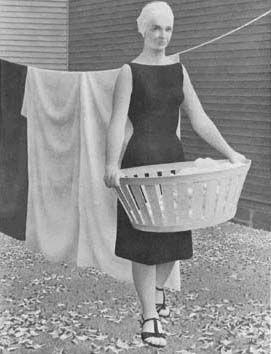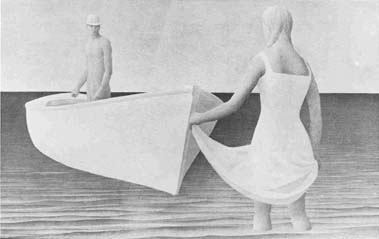
Bulletin 8 (IV:2), 1966
Home
Français
Introduction
History
Annual Index
Author &
Subject
Credits
Contact


Realism,
Surrealism and Celebration:
The Paintings of Alex Colville in the
Collection of the National Gallery of Canada
by Patrick A. E.
Hutchings
Senior Lecturer in Philosophy
University of Western
Australia
Pages 1 | 2
| 3 | 4 |
5 | 6
| 7 | 8 |
9 | 10
The rhythmic pattern of bodies, each progressively less jackknifed
as we read towards the foreground, could not be rendered in meta!
exactly like this. But the solidity of each individual figure is
essentially sculptural, and the pool, with its sharp green wavelets,
is like the water around Renoir's Laveuse. formal, cast and
fettled; only the splash of the middle figure of the foreground
group asserts the expected softness of a painted surface. The girls
are of polished bronze, the tight unglamourous swimsuits are like
wound wire or electroplating, and the surface of each figure has the
uniform visual tension of a finely machined metal artifact. And yet
the picture remains, pre-eminently, an action photo taken at the
high school swimming pool.
Arrested and monumentalized like this, with the banal details of
their surroundings resolved into an elegant formal pattern, these
anonymous figures become permanent and memorable. Their
Maillol-like solidity gives them the same importance as pieces of
public sculpture, those statues with which the past celebrated its
values. The values have changed, but the celebrative impulse
remains.
Man may fit into his environment snugly enough, but human activity
inevitably brings alienation with it.
Work, of its essence, entails the alienation of man from the
mindless and effortless round of nature; and as often as not work
itself brings about a further alienation, of the person from
his own function as a worker: labour may be necessary but a man
cannot identify himself simply with this necessity.
The double theme of alienation can be traced in the painting Woman
at Clothes Line, 1957 (Fig. 4), a picture of work, removed
subtly but absolutely from the stereotypes of social realism, and
plumbing depths deeper than the Marxist might care to go. This is a
painting of a housewife who does not enjoy hanging out damp washing
on a chili day in fall. Of course, but it is something else as well.
The woman's figure is curiously stiff and wooden, her face is almost
schematic, and only the eyes, which look beyond the present
situation, betray any life or animation. The person has withdrawn,
leaving her body as a functional instrument of work: her arms and
legs are solid and well defined, but she is absent. In a
sense she is not needed here, only her splendid, solid limbs,
and prehensile hands.
The withdrawal of the person from her function of work underlines
the larger theme of the Romantic Tragedy, (4) of the essential and
necessary alienation of man from nature; and the yellow leaves on
the green grass look more real than the woman, just because Nature's
cycle has an inevitability and a grace which the human round has
not. The indifferent objects, the wash-basket of split wood, the
brick damp-course, and the narrow clapboards of the house all seem
to relate more easily to the smooth course of the seasons than this
intense, labouring figure who can dominate nature only by work:
trivial, effortful and necessary action.
The woman, and the seasons, both process inexorably and
majestically. And she, like the fallen leaves on the cold green
grass, has come to an autumn, but here to one more fruitful than
theirs. This notion of a procession is magnificently
conveyed by the strong measured line of the blankets, which thrusts
her forward - dark grey, pale grey, and summer white - and which
issues now in this suburban Ceres, whose beautiful feet plant
themselves so firmly on the waste of Nature's diurnal course.
Colville is not telling a story as a nineteenth-century realist
would; he is painting an emblem which we feel, or grasp intuitively
as an aesthetic idea. We are not supposed to read the picture off
into a series of propositions, or reduce it to the elements of its
anecdote, though if we are to 'say what it means to us', we must
perforce say something.
But, though painting is not propositional, this canvas is
metaphysically true, that is to say it represents something
fundamental in reality and in the human condition. Human activity,
as Aristotle puts it, 'finishes the job where Nature fails', (5) and
human action both follows and subdues nature, subduing only in so
far as it follows, and always making up what is wanting. Human craft
- here techné, cunning and skill are all crammed into
one word - overcomes Nature in the end. Work is the means, and the
price, of man's mastery over nature, in sudore vultus tui
vesceris pane, (6) and even in our remarkably efficient
western societies and our comfortable suburbs, man dominates the
world only in a glorious servitude to it.
This housewife knows more surely perhaps even than Hobbes that man
in a 'state of nature' would be man in a state of confusion; and
only her efforts, incessant. wearisome and necessary, can bring
about a domestic order as elegant in its way as Nature's own economy
is, but. unlike it. never quite mindless or quite effortless.
As we have said, the extreme realism of tempera and other
hard-surface techniques can slide into surrealism, and there are
elements both of genuine and of merely apparent surrealism in
Colville; we shall discuss these presently. But before we come to
them it is instructive to look at an example of what one may call,
for want of a better expression, Colville's ecstatic
pre-Raphaelitism.
The lyrical Hound in Field (reproduced on cover) is as
meticulous hair for hair as Holman Hunt's Scapegoat, (7) but
it is quite without message: it illustrates no theme, great or
small, and there is no anthropomorphic anguish in the dog's
eye. He is closer to a Kodachrome than to a Landseer.
This purely lyrical use of near-surrealism produces great tension in
the observer: what is meant beyond the lyrical fact? What is the
ulterior sense of this picture? There is nothing ulterior here,
unless it is the sheer love of craft and illusion, a passion for
realism which survives the absolute conquest of the camera. (8) But
searching for motives of this sort brings us dangerously close to
questions about the artist's intentions and to the intentional
fallacy, when what we are after is the intentionality of his
artifacts. Here, the point of the picture almost seems to be just
this, to invite the question, and to block off any answer with a
disclaimer. We are compelled to attend to the lyrical artifact,
simply. This sort of lyricism which says nothing explicitry, but
which forces us to use the artifact as the concrete focus of its own
suggestions, and of whatever we ourselves may bring to it, has
literary analogues in things like Frost's Oust of Snow, or,
to take Canadian examples, in the short imagistic poems of W. W. E.
Ross.
Two of the Gallery's paintings, Woman, Man, and Boat, 1952
(Fig. 5), and Four Figures on a Wharf; 1952 ( Fig. 6)
, are positively but gentry surrealist, and they raise, convenientry,
a problem of critical phenomenology and classification that needs to
be faced: how far would it be pointful to look upon Colville's oeuvre
as in some general sense surrealistic? This is a large question,
and needs to be considered at some length.
One wants to borrow and apply to Colville the phrase that John
Canaday (9) coined for his essay on Magritte, 'delightful
disconcerter'. Colville's explicit surrealism is far less épatant
than even the mildest of Magritte, gentrer than Le Château
des Pyrénées (10) for instance, or La Condition
humaine, (11) and it is altogether cooler and more controlled;
the troubled dream itself has been recollected in tranquillity, and
the automatic writing of the unconscious subjected to classical
canons of style.
Next Page | Woman, Man and Boat
1 | 2
| 3 | 4 |
5 | 6
| 7 | 8 |
9 | 10
Annual Index | Author & Subject | Credits | Contact
This digital collection
was produced under contract to Canada's Digital Collections program,
Industry Canada.
"Digital
Collections Program, Copyright
© National Gallery of
Canada 2001"